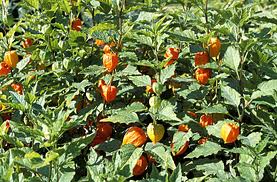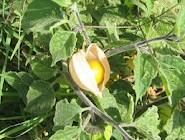Physalis
Ornamental - P. Alkekengii and its varieties are grown for the decorative value of their brilliantly colored, swollen calyces. These resemble miniature "Chinese Lanterns", thus one of the common names, Chinese Lantern Plant. Other popular names include Alkekengi and Winter Cherry. These perennials spread by means of underground stems. In gardens, they are sometimes grown as annuals. The Chinese Lantern Plant and its varieties are very pretty in the garden in late summer. The stems bearing the large orange "fruits" are valued for cutting and bringing indoors during the fall and winter months. They last a long time and look quite handsome in a vase. "Fruits" refers to the swollen calyces of the white flowers, which open early in the summer. If they are to be brought in to decorate the house, the stems bearing the pretty calyces should be cut as soon as they have developed their full coloring.
Vegetable - P. pruinosa, P. peruviana and P. ixocarpa are grown for their edible fruits. They are described below. P. peruviana - Cape Gooseberry, Husk Tomato, or Ground Cherry. The Cape Gooseberry is hardly seen in the U.S. except in Pennsylvania Dutch country and parts of the Midwest. The sprawling vine grows up to 2 feet high and spreads 3 to 4 feet wide. The fruits are �- to �-inch in diameter and are encased in a loose, papery husk shaded with purple. When they are ripe, they resemble yellow Cherry Tomatoes. They are smaller and sweeter than Tomatillos and can be eaten raw or used in preserves.
P. pruinosa - Dwarf Cape Gooseberry, Strawberry Tomato, or Ground Cherry. This is the most popularly grown variety because at 18 to 20 inches high and 2 to 3 feet wide, it is smaller and more manageable than P. peruviana. The fruits are a lot like those of P. peruviana in flavor and size, but the husks are tight fitting and they curl back to expose the ripe fruits.
P. ixocarpa - Tomatillo, Jamberry, Mexican Husk Tomato, or Miltomate. The Tomatillo is a native of Mexico and requires a longer growing season and is more tender than the others. The shiny, flattened fruits are greenish-yellow and average 12 to 2 inches in diameter. They are encased in papery husks. The husks split, but don't fall off, as the fruits mature and take on a purplish hue. In Latin America, Tomatillos are crushed and used in sauces. They have an agreeable, but not sweet flavor. The plants grow up to 3 feet high and their branches are covered in heart-shaped, elongated leaves with long stems.
Pot Cultivation
Ornamental - These plants are easily grown in any well-drained soil in a position full of sun. They won't flourish in a shady place or in heavy, poorly drained ground. Light soil is the best for their development. Heavy ground can be enhanced, however, by digging deeply and adding sand and compost. Planting should be done in early fall or spring. Chinese Lantern Plants will spread quickly in soil that suits them, so they will need to be lifted and separated to prevent crowding. Overcrowding will result in a lack of flowers and fruits.Vegetable - P. peruviana, Cape Gooseberry, should be grown in loamy soil. If the ground is full of clay, they should be planted in raised beds. Set them a foot apart. Use black plastic mulch. If you live in the Deep South, paint the black plastic white to reduce heat absorption. Don't dig manure or mulch into the soil or fertilize heavily; that will cause very lush growth at the expense of the fruits. Don't plant too many of these, because a mulched plant can produce up to 3 pounds of fruits. These fruits drop when they are ripe or nearly so. They are the sweetest when completely ripe. Plastic or packed straw mulch will keep dropped fruits clean. P. pruinosa, Dwarf Cape Gooseberry, is grown like Tomatoes. They should be spaced a foot apart. They need about 70 days of frost-free weather for fruits to mature. If whiteflies are a problem, spray the undersides of the leaves with an insecticidal soap. The fruits of this plant also drop when they're ripe. They can be prepared like vegetables or eaten as a fruit. The flavor slightly resembles apples. P. ixocarpa, Tomatillo, needs just about the same care as the others. They prefer warm, dry climates. They don't last as long in humid, rainy climates. Tomatillos can be grown as far north as the central midwest. The flavor of Tomatillos increase with maturity. Harvest after the husks split. Fruits that feel too hard should be set aside to finish ripening. Seeds from dropped fruits may sprout and cause a weed problem.
Propagation
Ornamental - The easiest way to increase these plants is to lift and separate them into rooted pieces in the spring and replant them. They may also be started from seeds, which are sown in flats of sandy soil or directly outside. Those sown directly outside should be thinned to 6 inches apart before they become too crowded.Vegetable - Seeds should be started indoors and grown like Tomatoes. Tomatillo seeds may be obtained (if you can find any to purchase) by buying ripe fruit, let it start to decay and mash and strain the pulp for seeds. Let the seeds dry before planting.
 |
 |
P. Alkekengii |
P. pruinosa |
VARIETIES
- Ornamental - P. Alkekengii; Franchettii; Bunyardii; monstrosa; nana.
- Vegetable - P. peruviana; P. pruinosa; P. ixocarpa




